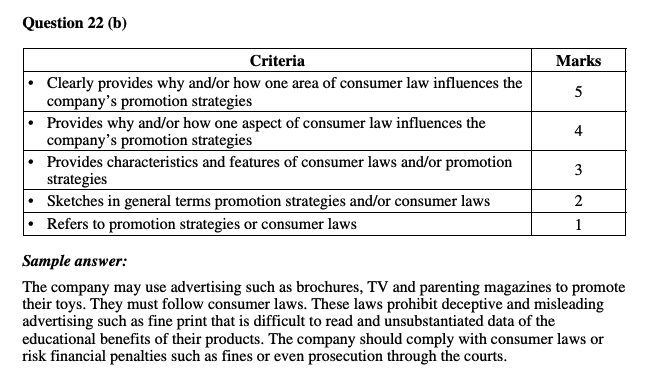Looking to maximise your marks when you sit the HSC Business Studies exam?
Well if you didn’t already know, the Short Answers section of the exam makes up the majority of the marks of the paper, so you’ll want to do really well in this section.
Lucky for you, we’ve come up with 5 steps for you to follow in order to ace your short answers!
Now what are you waiting for? Let’s get started.
Why does the HSC Business Studies Short Answers section matter?
Step 1: Study the Marking Guidelines
Step 2: Learn Directive Verbs
Step 3: Follow DPEEL
Step 4: Don’t Repeat the Question More Than Needed
Step 5: Edit – Consider How Much Value Each Word Adds
Why does the HSC Business Studies Short Answers section matter?
While most of the attention (and subsequent stress) goes towards the Business Report and Extended Response in the HSC Business Studies paper, it is the Short Answers that actually constitute the majority of the marks.
A whopping 40/100 marks of the exam.
Just like the Business Report and the Extended Response have their own conventions and styles, the Business Studies Short Answer section is marked in a very unique manner and hence must also be answered with a very specific approach.
You need to hit the bullseye. This emphasises the succinct precision needed in ensuring your answer leaves the marker with no doubt but to award you all available marks.
With all that being said, you’ll want to do as well as you can in this section, and not just the Business Report and Extended Response, so you can really make the most of your marks!
Now let’s get into those 5 steps.
Step 1: Study the Marking Guidelines
Every year, NESA will release the HSC paper shortly after the conclusion of its examination period. Alongside, it will also release the marking guidelines used by the markers at the Marking Centre, hence allowing you to get into the minds of the markers and see EXACTLY how marks are allocated. It is ESSENTIAL you access it.
Check out the 2017 Marking Guidelines along with the 2017 exam paper.
Let’s take a look at an example from Question 22 (b) in the 2017 Business Studies Exam.
Explain the influence of consumer laws on this company’s promotion strategies. (5 marks)
In order to score a 5, the marker will need to identify: a ‘clear’ explanation of why/how consumer law influences the company’s promotion strategies. While what constitutes ‘clear’ is subjective, many 5 or 6 mark questions will also ask for ‘detailed’ responses, which therefore suggest that in order to maximise your mark, you must include as many RELEVANT details as possible. Looking at the sample answer, we can see that rather than stating:
‘The company may use advertising to promote its products but must follow consumer laws.’
The sample answer has made the same argument but demonstrated additional knowledge and made clear the relationship between advertising and consumer law:
These laws prohibit deceptive and misleading advertising such as fine print that is difficult to read and unsubstantiated data of the educational benefits of their products.
Step 2: Learn Directive Verbs
When answering short answer questions in the HSC Business Studies exam, it is crucial that you differentiate between your directive verbs and ACTUALLY do what is asked of you.
Simply writing everything you know about the concept is insufficient, and often takes up precious space in your answer booklet which could be better used ANSWERING THE QUESTION.
Some common verbs used in HSC Business Studies include:
Analyse: Identify components and the relationship between them; draw out and relate implications
Assess: Make a judgement of value, quality, outcomes, results or size
Describe: provide characteristics and features
Discuss: Identify issues and provide points for and/or against
Explain: Relate cause and effect; make the relationships between things evident; provide why and/or how
Evaluate: Make a judgement based on criteria; determine the value of
Outline: Sketch in general terms; indicate the main features of
Recommend: Provide reasons in favour
Again, if you study the marking criteria you will see explicit differences in how a Short Answer is marked depending on the directive verb used.
Are you looking for personalised HSC Business Studies support? Our expert tutors can support you at our Hills District Campus, online or in your own home.
Step 3: Follow DPEEL
To provide a basic structure, follow DPEEL which will ensure you address all HSC Business Studies elements in your response.
Definition: Ensure you are defining the concept in the question to reflect your understanding. Can be integrated into the response and does not need its own sentence.
Point: Attack the question and pinpoint what your overall answer will be, akin to a mini thesis.
Explain: Provide further details that elaborate on your point. Depending on which directive verb you are asked, this is also where you can start to show a cause and effect (explain) or make a judgement (assess).
Evidence: Usually questions will involve a statement at the beginning that provides some context for the question. Integrate this into your response to illustrate your explanation further.
Link: Conclude your response by using a link to tie up all your points.
In the example above:
- Point is in orange
- Definition and explanation is in yellow
- Evidence is in green
- Link is in blue
Step 4: Don’t Repeat the Question More Than Needed
A very common mistake I see students make is they take what teachers correctly advise them to do by ‘answering the question’ with the words in the question — but they do too much.
In Short Answers you only have a limited space literally and figuratively to make an impression AND above all, provide enough depth to answer the question fully.
Just answer enough to establish a clear attack (mini thesis) and then LAUNCH into your point.
For example:
Question 23 (b) Outline an issue that could arise during the acquisition process
An issue during acquisition is…..
There is no need to rewrite the entire statement — this is a waste of time!
Step 5: Edit – Consider how much value each word adds
Finally, it is essential that you reread your answers and edit them accordingly. Below are THREE easy steps to help you refine and reinforce those responses.
#1: Check if you have answered the question fully.
This includes:
A clear point and thesis sentence that states your answer to the question.
Qualified your answer throughout your response by using the correct modality (definitely, absolutely, to a limited extent, to some extent) or qualifier (somewhat, inconclusively, may).
#2: Included all relevant details and structured them logically.
This is supported using:
Transition signals (furthermore, hence, as a result, this leads to, but, however) — these are ‘linking’ words which add logical sequencing to your DPEEL structure to create a sustained Short Answer response.
#3: Made explicit reference to the scenario (evidence in your DPEEL structure) or your own case study if asked to provide one.
Remember that the aim of these case studies, real or hypothetical, is to demonstrate your understanding of how concepts are applied in real life.
A very general rule of thumb you can use as you write is to mentally ‘assign’ one mark to every idea. So long as each idea is not simply a repetition of an idea you have already written, this will help guide your response length and depth.
Well, now that you have learned how to write killer Short Answer responses for Business Studies, go on and practise with past papers! Practise, practise, practise!
For your Business Studies exam, there will be other sections you’ll want to prep for. We’ve got a guide on preparing for the Extended Response, as well as acing the Business Report section for the HSC Business Studies exam!
Are you looking for some extra help with acing your HSC Business Studies exam?
We pride ourselves on our inspirational HSC Business Studies coaches and mentors!
We offer tutoring and mentoring for Years K-12 in a large variety of subjects, with personalised lessons conducted one-on-one in your home or at one of our state of the art campuses in Hornsby or the Hills!
To find out more and get started with an inspirational tutor and mentor get in touch today!
Give us a ring on 1300 267 888, email us at [email protected] or check us out on TikTok!
Terry Huang completed his Bachelor of Secondary Education with a Bachelor of Commerce at the University of New South Wales. A strong believer that lessons should be engaging, relevant, and effective, his hustle and teaching approach have led to his recognition on the UNSW Faculty of Social Sciences Dean’s List for Academic Excellence, the NSW Teachers Federation Future Teacher scholarship, and the New Colombo Plan program. Terry enjoys listening to Kanye West, learning about cryptocurrency and memorising scenes from The Office.






